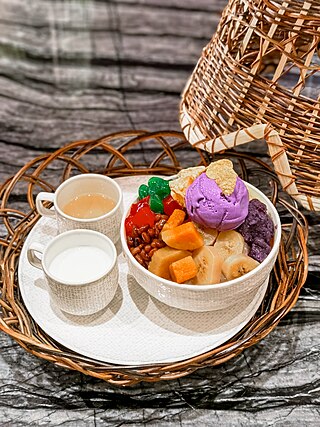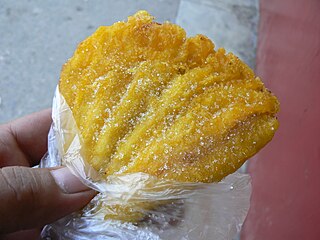
Cooking bananas are a group of starchy banana cultivars in the genus Musa whose fruits are generally used in cooking. They are not eaten raw and generally starchy. Many cooking bananas are referred to as plantains or 'green bananas'. In botanical usage, the term "plantain" is used only for true plantains, while other starchy cultivars used for cooking are called "cooking bananas". True plantains are cooking cultivars belonging to the AAB group, while cooking bananas are any cooking cultivar belonging to the AAB, AAA, ABB, or BBB groups. The currently accepted scientific name for all such cultivars in these groups is Musa × paradisiaca. Fe'i bananas from the Pacific Islands are often eaten roasted or boiled, and are thus informally referred to as "mountain plantains", but they do not belong to any of the species from which all modern banana cultivars are descended.

Filipino cuisine is composed of the cuisines of more than a hundred distinct ethnolinguistic groups found throughout the Philippine archipelago. A majority of mainstream Filipino dishes that compose Filipino cuisine are from the food traditions of various ethnolinguistic groups and tribes of the archipelago, including the Ilocano, Pangasinan, Kapampangan, Tagalog, Bicolano, Visayan, Chavacano, and Maranao ethnolinguistic groups. The dishes associated with these groups evolved over the centuries from a largely indigenous base shared with maritime Southeast Asia with varied influences from Chinese, Spanish, and American cuisines, in line with the major waves of influence that had enriched the cultures of the archipelago, and adapted using indigenous ingredients to meet local preferences.

Halo-halo, also spelled haluhalo, Tagalog for "mixed", is a popular cold dessert in the Philippines made up of crushed ice, evaporated milk or coconut milk, and various ingredients including side dishes such as ube jam, sweetened kidney beans or garbanzo beans, coconut strips, [[]], [[]] (agar), pinipig, boiled taro or soft yams in cubes, flan, slices or portions of fruit preserves and other root crop preserves. The dessert is topped with a scoop of ube ice cream. It is usually prepared in a tall clear glass and served with a long spoon. Halo-halo is considered to be the unofficial national dessert of the Philippines.

Picadillo is a traditional dish in many Latin American countries including Mexico and Cuba, as well as the Philippines. It is made with ground meat, tomatoes, and also raisins, olives, and other ingredients that vary by region. The name comes from the Spanish word picar, meaning "to mince".

The banana leaf is the leaf of the banana plant, which may produce up to 40 leaves in a growing cycle. The leaves have a wide range of applications because they are large, flexible, waterproof and decorative. They are used for cooking, wrapping, and food-serving in a wide range of cuisines in tropical and subtropical areas. They are used for decorative and symbolic purposes in numerous Hindu and Buddhist ceremonies. In traditional homebuilding in tropical areas, roofs and fences are made with dry banana-leaf thatch. Bananas and palm leaves were historically the primary writing surfaces in many nations of South and Southeast Asia.

Puto is a Filipino steamed rice cake, traditionally made from slightly fermented rice dough (galapong). It is eaten as is or as an accompaniment to a number of savoury dishes. Puto is also an umbrella term for various kinds of indigenous steamed cakes, including those made without rice. It is a sub-type of kakanin.

Kinilaw is a raw seafood dish and preparation method native to the Philippines. It is sometimes also referred to as Philippine ceviche due to its similarity to the Latin American dish ceviche. It is more accurately a cooking process that relies on vinegar and acidic fruit juices to denature the ingredients, rather than a dish, as it can also be used to prepare meat and vegetables. Kinilaw dishes are usually eaten as appetizers before a meal, or as finger food with alcoholic drinks. Kinilaw is also sometimes called kilawin, especially in the northern Philippines, but the term kilawin more commonly applies to a similar lightly grilled meat dish.

Banana cue or bananacue is a popular snack food or street food in the Philippines. It is a portmanteau of banana and barbecue, which in Philippine English refers to meat cooked in a style similar to satay.

Pinaypay, also known as maruya, is a type of banana fritter from the Philippines. It is usually made from saba bananas. The most common variant is prepared by cutting bananas into thin slices on the sides and forming it into a fan-like shape, and coating it in batter and deep frying them. They are then sprinkled with sugar. Though not traditional, they may also be served with slices of jackfruit preserved in syrup or ice cream. Pinaypay are commonly sold as street food and food sellers at outdoor though they are also popular as home-made merienda snacks among Filipinos.

Pritong saging, also known as pritong saba, is a Filipino snack made from ripe saba or cardaba bananas sliced lengthwise and fried in oil. The bananas used are ideally very ripe, in which case it naturally caramelizes and no sugar is added. When younger starchier bananas are used, it is often eaten dipped in muscovado sugar, syrup, or coconut caramel (latik). Unlike the similar pisang goreng of neighboring countries, it is not as popular as street food. Instead it is regarded as a simple home-made snack, most commonly eaten for merienda.

Paksiw is a Filipino style of cooking, whose name means "to cook and simmer in vinegar". Common dishes bearing the term, however, can vary substantially depending on what is being cooked.

Ube halaya or halayang ube is a Philippine dessert made from boiled and mashed purple yam. Ube halaya is the main base in ube/purple yam flavored-pastries and ube ice cream. It can also be incorporated in other desserts such as halo-halo. It is also commonly anglicized as ube jam, or called by its original native name, nilupak na ube.

Balbacua, also spelled balbakwa or balbakoa, is a Filipino beef stew made from beef, collagen-rich beef parts, and various spices cooked for several hours until very tender. It is typically served with white rice or misua or miki noodles. It originates from the Visayan regions of the Visayas and Mindanao islands.

Nilaga is a traditional meat stew or soup from the Philippines, made with boiled beef or pork mixed with various vegetables. It is typically eaten with white rice and is served with soy sauce, patis, labuyo chilis, and calamansi on the side.

Pata tim, also spelled patatim, is a Filipino braised pork hock dish slow-cooked until very tender in soy sauce, black peppercorns, garlic, bay leaves, and star anise sweetened with muscovado sugar. It also commonly includes péchay and mushrooms. The dish is commonly served in regions in the Philippines with large Chinese Filipino populations, especially in the Binondo district of Manila.

Minatamis na saging is a Filipino dessert made with chopped saba bananas cooked in a sweet syrup (arnibal) made with muscovado sugar and water. Some recipes also add a little bit of salt and pandan leaf or vanilla extract. Other ingredients can also be added like sweet potato, sago, or other fruits like jackfruit. It can be eaten on its own or added as an ingredient to other desserts. Adding the dessert over milk and shaved ice also results in another dessert known as saba con yelo.

Ginataang saba is a Filipino dessert made from ripe saba or cardaba bananas stewed in sweetened coconut milk. It is traditionally eaten warm, but it can also be eaten chilled. It is a type of ginataan. It is also known as saba sa gata, ginataang saging, sareala, among other names. Sago pearls are also commonly added to the dish, in which case it becomes ginataang saging at sago.

Kulawo is a Filipino salad made with either minced banana blossoms or grilled eggplants cooked in coconut milk that is distinctively extracted from grated coconut meat toasted on live coals. It is a pre-colonial dish that originates from the provinces of Laguna and Quezon. Kulawo is a type of kilawin and ginataan. It is fully vegan and has a unique smoky taste that has been compared to smoked meat or fish dishes.

Pinais is a Filipino style of cooking from the Southern Tagalog region consisting of fish, small shrimp, or other seafood and shredded coconut wrapped in banana and steamed or boiled in plain water or coconut water with sun-dried sour kamias fruits. It is also simply called sinaing. There are several types of pinais based on the main ingredients and their preparation can vary significantly. They are eaten with white rice.





















